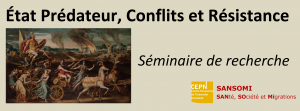
Matinée “Prédation et protection sociale” – 10h30-12h30 Philippe Batifoulier, Nicolas Da Silva et Mehrdad Vahabi (Université Paris 13, CEPN) – discussion par Michael Zemmour (CES, Université Paris 1, LIEPP) Ce travail a pour objet de relire l’histoire de l’Etat providence français à la lumière de la théorie d’un Etat prédateur. On oppose une approche de la protection sociale […]


